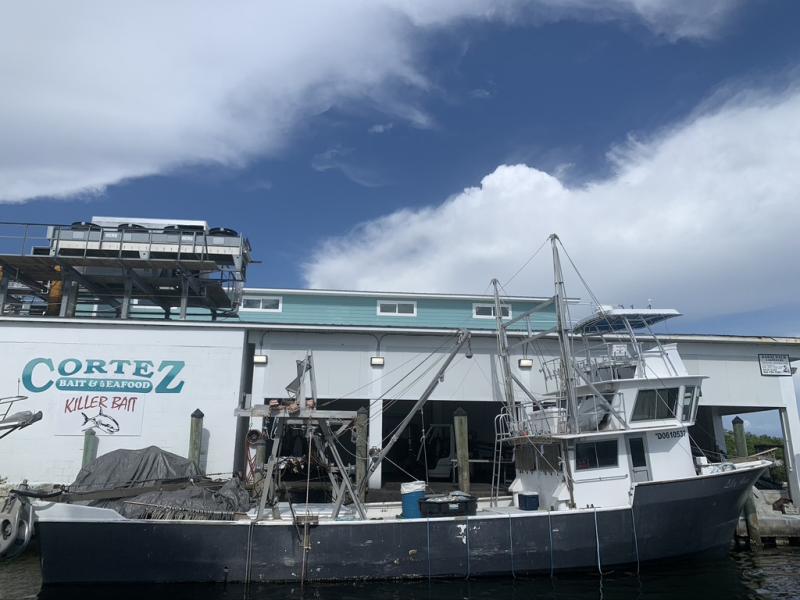“How do you see aquaculture influencing the community over time?” asks Dr. Adriane Michaelis, a social scientist at NOAA’s Southeast Fisheries Science Center, during an oral history interview with a local seafood chef in Sarasota, Florida.
As part of an anthropological case studies project on coastal communities, Dr. Michaelis has traveled to Florida’s gulf coast to record community members’ perspectives on aquaculture. In this project, she is looking to hear from those directly connected to the seafood industry such as fishers, seafood buyers, and restaurateurs. She also wants to hear from community members who may experience the effects of aquaculture in less obvious ways.
Through these case studies, Dr. Michaelis is broadening our understanding of public views on aquaculture in coastal communities across the Gulf of Mexico as well as Southern California. Her work is an example of expanding aquaculture social science capacity at NOAA, strengthening a vital dimension of aquaculture planning.
“For aquaculture, there might be a space that works well economically, scientifically, and environmentally, but the views of the public must be taken into account as well,” says Dr. Michaelis. “These are the communities at the center of this new endeavor; we need to hear their concerns and expectations.”
Integrating Social Science Into Aquaculture Planning
Seeking to support sustainable marine aquaculture growth, NOAA is leading a planning effort to identify Aquaculture Opportunity Areas. Last fall, NOAA released two Atlases that compiled the best scientific information available to determine geographic areas that are environmentally, socially, and economically appropriate for commercial aquaculture in the federal waters of Southern California and the Gulf of Mexico. NOAA social scientists have been supporting this planning process through research efforts to enhance our understanding of coastal communities in these regions, including how they perceive and might interact with aquaculture. These social science data and insights can be used in siting decisions by providing an opportunity for aquaculture planning efforts to align with the values and assets of a coastal community.
The outcomes of Dr. Michaelis’s project will play an important role in understanding where future aquaculture growth may be desired and perceived as beneficial to coastal communities. This knowledge can lead to better aquaculture siting and management decisions. The first step in this project is learning more about 12 coastal communities' opinions on aquaculture by visiting and collecting oral histories. It will record community members’ stories and perspectives in two communities each in Florida, Alabama, Mississippi, Louisiana, Texas, and Southern California. By including those whose perspectives may have not been heard in the past, Dr. Michaelis’s work will expand the range of voices on aquaculture and provide the opportunity for more people to see themselves represented in the conversation. “These case studies are about showing that a broad range of views on aquaculture exist, especially views that haven’t been heard before,” says Dr. Michaelis.
The work of Dr. Amy Freitag of NOAA’s National Centers for Coastal Ocean Science complements this in-depth, community-level data. It provides a broader perspective on potential aquaculture communities through existing socioeconomic data. Extending a pre-existing knowledge base from the Integrated Ecosystem Assessment effort, NCCOS social scientists are using social indicators to predict how an aquaculture farm might affect a coastal community. As Dr. Freitag explains, the main goal of the assessment effort is to simultaneously consider a range of different factors (e.g., income, available labor, and sea level rise) and how they may interact with each other.
While both Dr. Michaelis’s case studies and the NCCOS social indicators project evaluate the same communities, they do so through different lenses and dimensions. As Dr. Freitag notes, “there’s a need for both secondary, 500ft-scale data and the community-level work that Dr. Michaelis does; understanding how people’s culture is valued as much as economic considerations.”
Collecting Oral Histories on Aquaculture: Case Studies Project
For the first phase of the project, Dr. Michaelis is traveling to each of the 12 identified communities to speak with community members and capture their perspectives on aquaculture as oral histories. These recordings will then be transcribed and analyzed for themes. They will offer in-depth and personal qualitative data to deepen our understanding of what challenges, concerns, and experiences a coastal community might have regarding aquaculture growth.
Dr. Michaelis plans to publish her work as a peer-reviewed scientific publication, advancing aquaculture social science literature. Additionally, this publication holds the potential for providing an opportunity for folks who have not previously seen themselves represented in aquaculture conversations to hear the perspective of someone with whom they can relate.
“For people who maybe haven’t heard much about aquaculture, seeing and hearing someone who looks and sounds like them might open them up more to aquaculture and bring them into the conversation,” says Dr. Michaelis.
Building a holistic understanding of these communities is essential to the development of environmentally, economically, and socially sustainable marine aquaculture. In broadening our knowledge of community perspectives, NOAA social science offers a meaningful opportunity for the collaborative growth of aquaculture that can benefit and uplift coastal communities.





